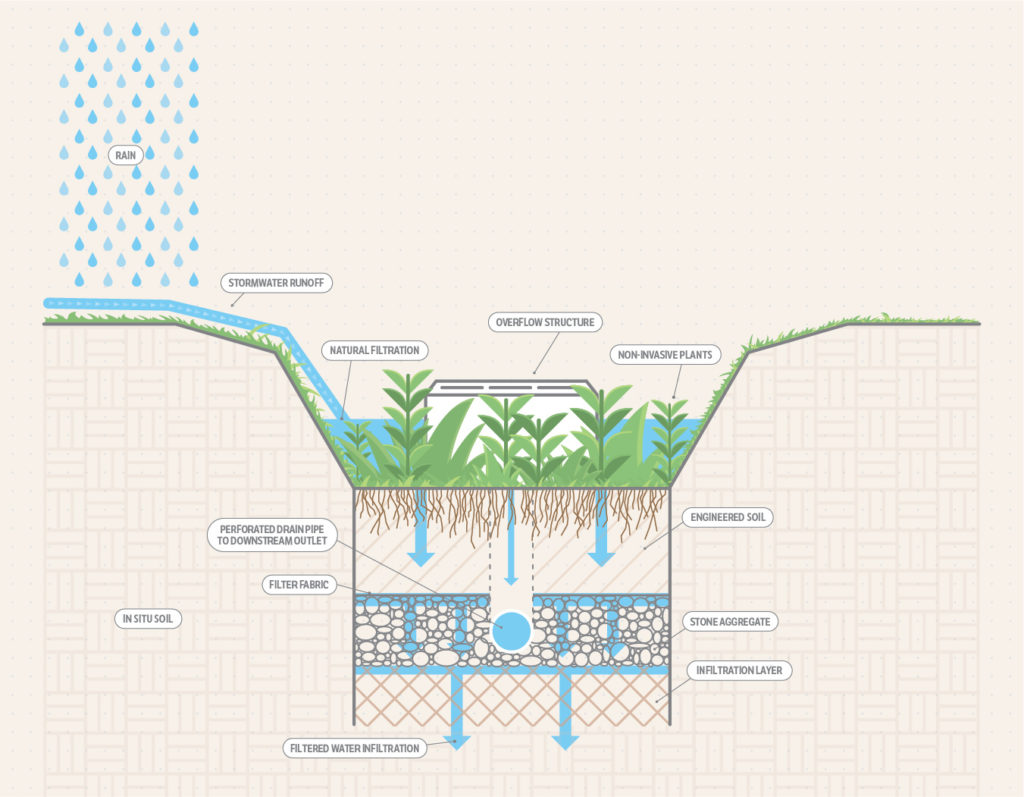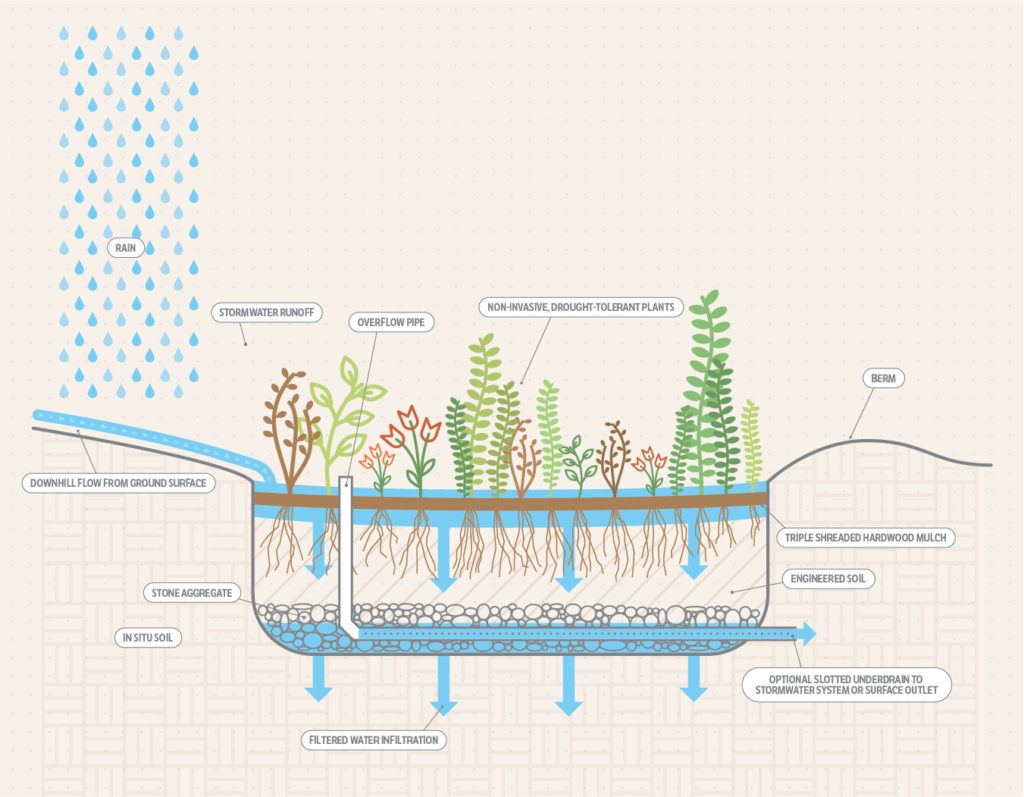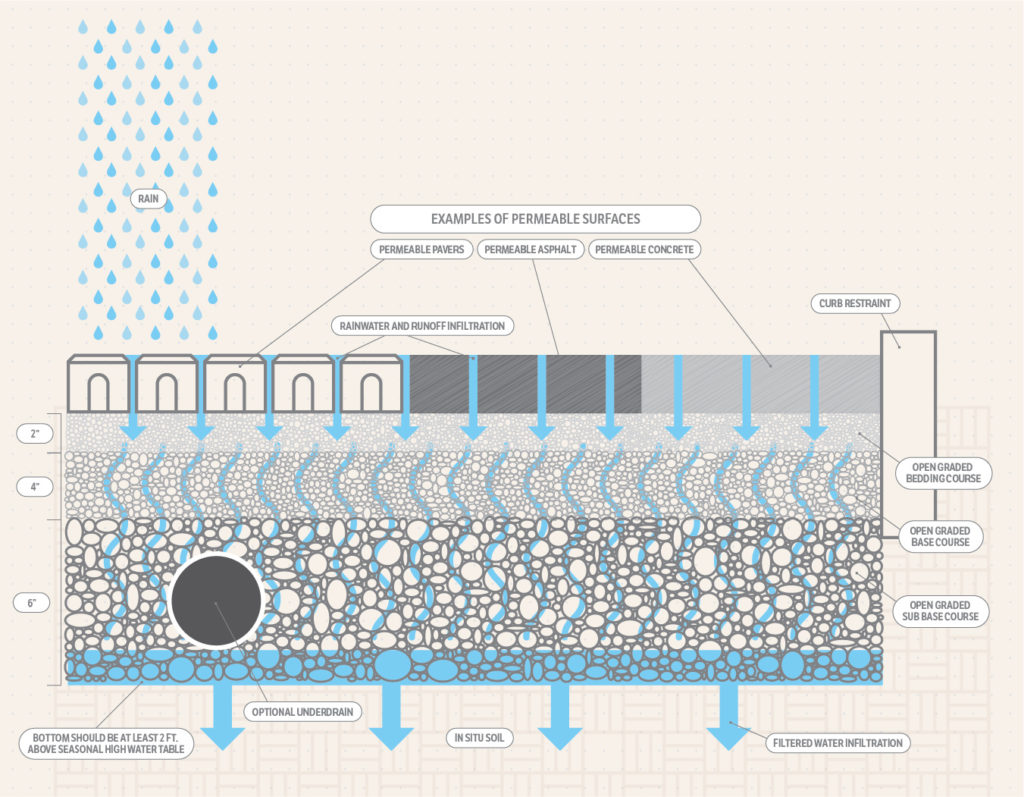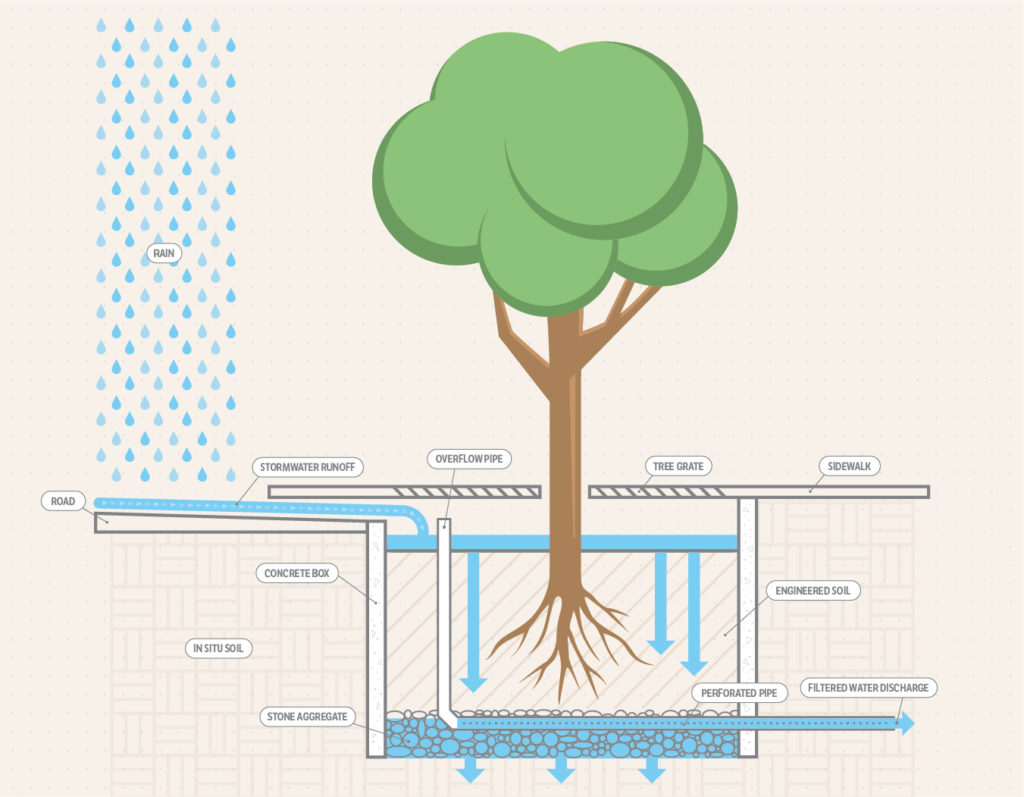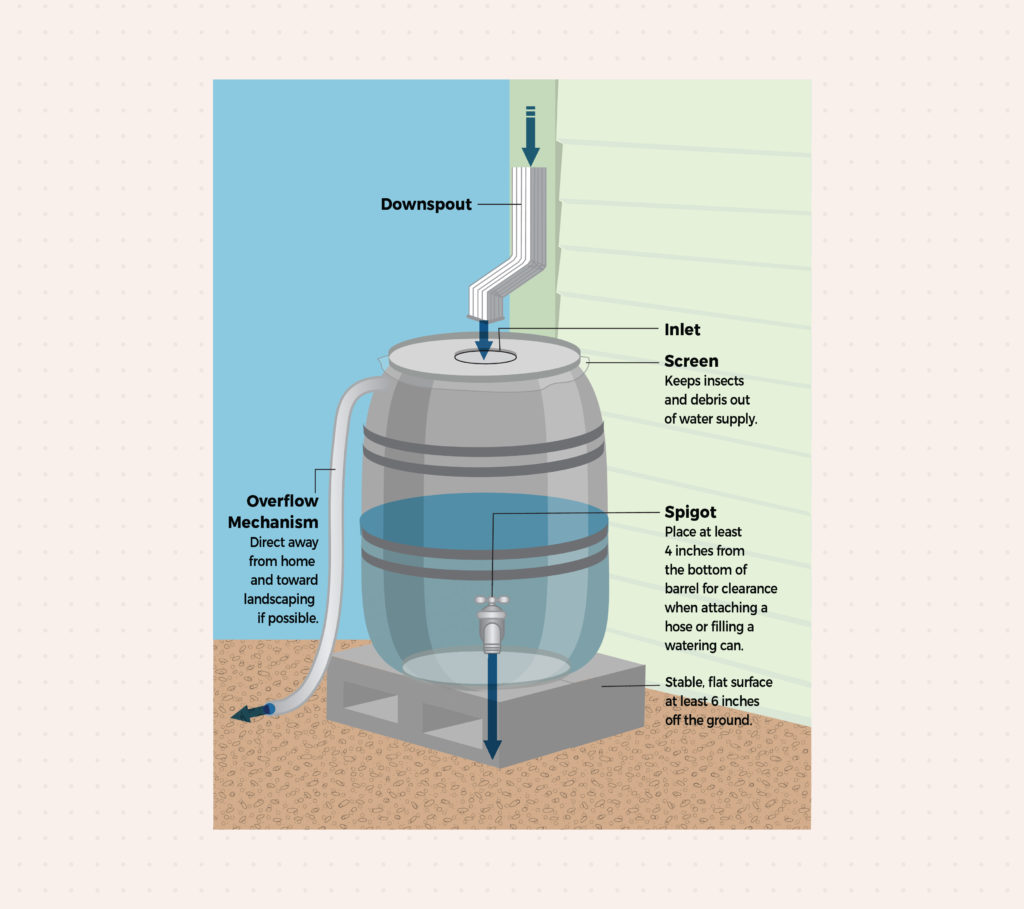Green stormwater infrastructure (GSI) can be used to supplement or replace traditional gray stormwater infrastructure for managing the impacts of rain in urban areas.
GSI reduces pollution and treats stormwater by retaining rainfall near its source instead of directing it to a centralized pond or treatment system.
These techniques deliver environmental, social and economic benefits to communities. When communities introduce green stormwater infrastructure, everyone wins.
Benefits of GSI
Environmental
- Reduces water pollution and improves quality of ground and surface waters.
- Reduces urban heat island effect.
- Protects and enhances aquatic and wildlife habitats.
Social
- Improves aesthetics of communities.
- Improves water and air quality.
- Increases appeal of recreational opportunities.
Economic
- Reduces clearing and grading costs, and long-term costs of stormwater management.
- Increases property values.
- Lowers heating and energy costs.

Stormwater Management 101
When water evaporates from the Earth’s surface, forms clouds and makes its journey back to the ground as rain, much of it soaks into the ground to join the aquifer. The water cycle is interrupted when we build “impervious surfaces” such as roads, parking lots and houses, which prevent rain from filtering into the landscape. Uncontrolled stormwater runoff can contribute to flooding and erosion issues, potentially causing harm to property and our environment.
The main purpose of most gray stormwater infrastructure is flood control. With gray infrastructure, stormwater runoff is collected and conveyed quickly to a centralized system of holding ponds or storage systems that fill quickly and then slowly release water, reducing the downstream flood risk. Gray infrastructure can be enhanced through the use of curb inlet baskets, baffle boxes, exfiltration trenches, stormwater pond littoral zones, and nutrient-reducing media to reduce trash and other pollutants.
GSI can complement traditional stormwater infrastructure when designed correctly. GSI techniques can be designed with emergency overflow systems that direct water into traditional gray infrastructure during major rain events.
In urban areas, GSI should either be sized to manage flooding events or be coupled with traditional gray infrastructure approaches that can address flood risks associated with major storm events.
How We Manage Stormwater
Gray Stormwater Infrastructure
Green Stormwater Infrastructure
Materials and Approach
Uses impervious concrete gutters, culverts, storm drains and similar methods to move excess water out of the area and into stormwater ponds or local waterbodies.
Uses nature-based bioswales, rain gardens, pervious pavement, tree box filters and similar methods to percolate and filter water close to its source.
Water Quality
Collects stormwater runoff – often contaminated by pollutants such as gasoline, oil and fertilizer – and runs it through a centralized treatment system to reduce these pollutants before being released back into the environment.
Retains stormwater, letting it soak into the ground and filter through vegetation and sediment before it reaches the aquifer, thereby reducing contamination downstream. Most effective in urban areas with high concentrations of hard surfaces and no large spaces for stormwater treatment areas.
Flood Risk
Quickly redirects stormwater away from the environment and into treatment systems before discharging into waterbodies.
Allows water to seep into the natural landscape rather than pool on impervious surfaces and contribute to nuisance flooding potential. Supplements gray infrastructure during peak rainfall.
Water Supply
Steers stormwater runoff away from the landscape, preventing its infiltration and reducing the quantity of water available for use.
Directs rainwater and runoff into the ground to recharge the aquifer, our primary source of drinking water. Also encourages stormwater to be harvested for landscaping (via rain barrels) and some household uses.
Cost
Gray infrastructure requires high capital costs in the way of site grading, paving and the creation of large piping (plus land costs for detention facilities).
Capital expenses for green infrastructure may cost less than or about the same as gray infrastructure when additional socio-economic benefits are part of the equation. GSI also yields indirect economic benefits, including higher property values and aesthetic amenities.
Common Nature-Based Techniques for Stormwater Control
Many green infrastructure elements can be seamlessly integrated into public spaces, buildings, parks, roadways, parking lots and shopping centers. The following are four examples of GSI designed to restore stormwater’s natural movement:
Bioswale
A Bioswale is an alternative to concrete gutters and storm sewers for directing stormwater away from roadways or structures. They use vegetated low-lying areas and specialized soil mixes to treat, absorb and convey lower volumes of stormwater runoff to larger treatment systems.
In many ways, bioswales imitate the function of small natural creeks or streams. Because they are linear, bioswales are effective when placed along streets and within parking lots. Essentially a shallow trench or ditch, bioswales can be cost-effective to implement and can help slow foot traffic near businesses.
Bioswales provide landscaping that, depending on the plant species chosen, may create habitats for birds, butterflies and local wildlife.
Bioretention Cells
Bioretention cells, or commonly referred to as rain gardens, are shallow depressions with resilient plants that can handle temporary inundation/flooding and periods of drought. They allow stormwater to collect and soak directly into the soil.
Rain gardens vary in size and complexity. They can be planted to provide a food source for butterflies and other wildlife and can make a beautiful addition to the landscape.
Because of their visibility and aesthetic value, they’re an ideal choice for a demonstration project that builds enthusiasm for GSI among the public and community partners.
Permeable Pavement
Permeable pavement, which can be composed of pervious concrete, porous asphalt or interlocking pavers, quickly percolate rainwater where it falls as well as runoff from adjacent areas, allowing it to slowly soak into ground.
Parking lots, which make up a substantial portion of developed land areas, can be retrofitted or built with pervious surfaces from the start to significantly reduce runoff volumes.
Pervious pavement can be constructed to be similar in appearance to conventional asphalt surfacing, while pavers can be used to create intricate pavement designs. The implementation of pervious pavement of all types is often particularly cost-effective in places with high land values and recurrent nuisance flooding.
Tree Box Filter
Tree boxes provide direct filtration of runoff while also intercepting rain as it falls onto the leaves and branches of the non-invasive plant life. Tree boxes also reduce the urban heat island effect, offer shady relief from the sun and draw foot traffic to nearby business based on their aesthetically pleasing nature.
The boxes are typically installed on the street side of sidewalks, with long, narrow storage volumes below the pavement. Runoff is eliminated through a combination of trees taking up water (and nutrients), percolating into the ground and discharging to stormwater systems. Pollutants are removed as they pass through the soil media in the “box” and as trees absorb and filter pollutants.
Rainwater Harvesting Systems
Rainwater harvesting systems are installed on a level, firm surface to capture and store roof runoff. Rain barrels typically store between 50 and 200 gallons. They require very little space and can be connected to increase storage capacity. Cisterns for commercial use can store up to 10,000 gallons. Watering restrictions do not apply to harvested rain.
Capturing rain for later use can reduce water bills, moderate flooding, decrease erosion, and reduce the amount of moisture that reaches building foundations. Stored rain can be used to water plants, livestock or wildlife, wash vehicles, flush toilets and irrigate lawns Do not use it for cooking or drinking as it is not treated.
Green Roof
A green roof is a vegetated roof system where rainwater is taken up by plants and transpired into the air to reduce rainwater runoff from the roof. Green roofs provide an extra layer of insulation that reduces heating and cooling costs and are likely to extend the life of the roof by up to 10-20 years. Green roof vegetation enhances the building’s appearance, improves air quality and reduces the urban heat island effect.
Well-designed green roofs include subsystems for drainage, plant nourishment and support, and protect underlying waterproofing systems. Green roofs maintain growing conditions and manage heavy rainfall without sustaining damage from high winds, erosion or pooling water. Green roof engineered soil meets specific requirements, including grain-size, air spaces and moisture retention to store rainfall and support plants that meet site-specific “right plant-right place” requirements.
Test your stormwater smarts
How many quiz questions can you answer correctly?
